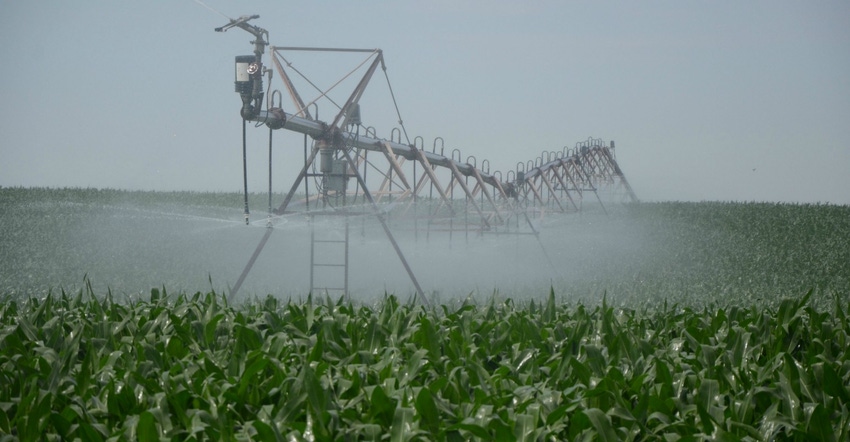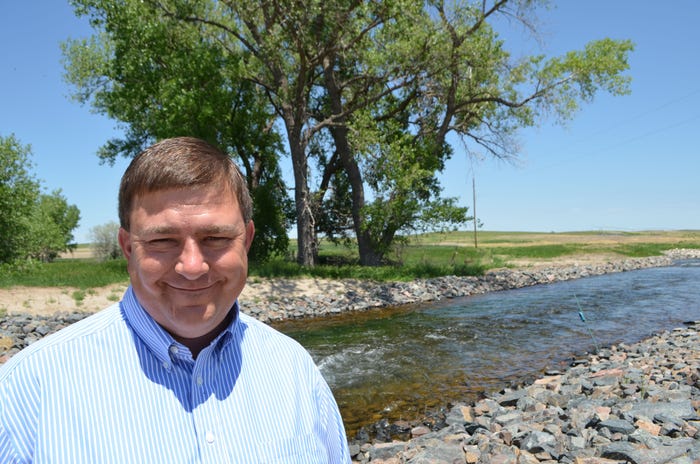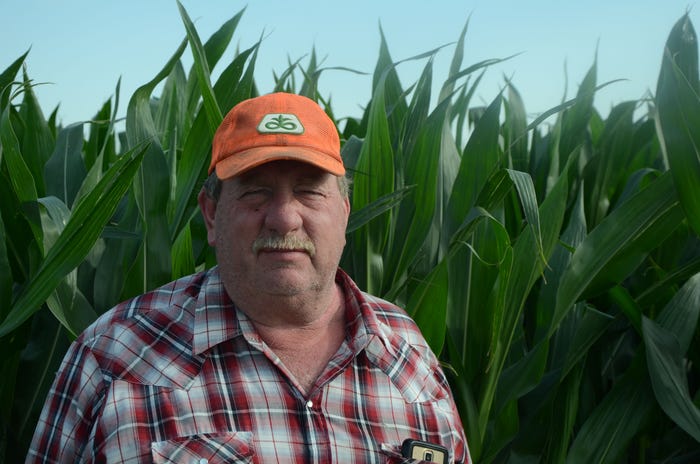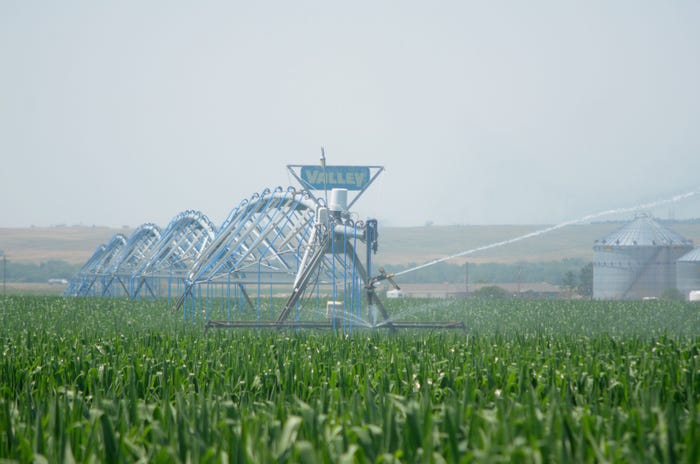
In western Nebraska, low-capacity wells and allocations are a common factor in planting and irrigation decisions. This includes planting populations. Here, dryland corners might have 10,000 or 11,000 corn plants per acre or less, while irrigated circles might have up to 36,000 down to 28,000.
But what about deficit irrigation? It's a question that Derrel Martin hears often.
"In plant physiology, we talk about leaf area index [LAI] — the amount of leaf area compared to underlying land area. Once that gets above a certain value, there's enough leaf area to absorb all the radiation and gas exchange in the atmosphere. You reach a point you get a full ET [evapotranspiration] rate," says Martin, University of Nebraska-Lincoln professor of biological systems engineering and Extension irrigation and water resources engineering specialist. "For many hybrids today, that's around 16,000 to 18,000 plants per acre. At 16,000 to 18,000, you've pretty much reached the full ET amount."
Of course, this means giving up yield, and that's why it's worth considering the water available.
"Given the amount of volume you have available to you, what population do you need to achieve that yield potential?" Martin asks. "Instead of 250 bushels per acre, maybe with water allocation you can only achieve 200. So, what population can I use to get 200 bushels instead of 250?"
Jasper Fanning, general manager of the Upper Republican Natural Resources District, notes reasons for implementing deficit irrigation vary on a case-by-case basis. However, the two biggest reasons are for a low-capacity well, or due to allocation restrictions.

MIXED BAG: Jasper Fanning of the Upper Republican Natural Resources District says several factors should be considered for deficit irrigation, including planting populations. "It's a mixed bag. It depends on the variety. There are a lot of different interactions to take into account," he says. "A variety with a lot of flex in its ear size; you can reduce the population. And if you get timely rains, those hybrids will respond more.”

"We have growers that might put one or two fields at a lower population and reduce water on those fields to make their allocation work for their entire farm. If they have a lower-capacity well, you'll see growers planting lower populations to match their well capacity," Fanning says. "It's common in areas with lower capacity wells. Everybody is deficit-irrigating to a certain extent, but most people probably don't consider it deficit irrigating. They're probably right on the edge of it."
2 pivots from 1 well
Some might plant corn populations closer to what might be higher dryland populations — around 18,000 to 20,000. Meanwhile, others might plant closer to the bottom rung of irrigated populations. It depends on the hybrid and the amount of water available.
For the last two years, Shawn Turner, who farms near Grant in the Upper Republican NRD, has managed a semi-irrigated pivot with lower populations — around 20,000 to 22,000. For Turner, deficit irrigation was a way to feed two pivots from one well in an allocated area. On one pivot was popcorn. On the other was short-season corn at a stand reduced to about two-thirds of what would be a full-irrigated field.
Last year, for example, he cut one pivot down to 20,000 to 22,000 plants per acre.

2 PIVOTS, 1 WELL: Shawn Turner stands in front of a low-population cornfield near Grant. For Turner, deficit irrigation is a way to feed two pivots from one well in an allocated area. Last year he cut populations on this pivot about 21,000 plants per acre — about two-thirds the population of a fully irrigated field. On the other pivot fed by the well was popcorn.

"We were on pretty limited water. With the rain we had, and probably another 4 inches of irrigation, it made somewhere between 180 to 190 bushels per acre," he says. "It was a decent crop. I'd say we probably doubled our yield with maybe 4 to 5 inches of irrigation water. Compared to our pure dryland fields, I feel we doubled our yield potential. We had to put a little more fertilizer on and more seed, but it would have made no sense to do that on dryland fields."
By comparison, his full-irrigated fields yielded up to 245 to 250 bushels per acre, and his irrigated popcorn on the other circle watered from the same well used to water the low-population field yielded 6,500 pounds per acre, comparable 240- to 250-bushel yields.
"Where we had full water and fertilizer, there was a nice return last year," Turner says. "To go from 22,000 up into the mid-30,000s with full water and fertilizer last year we also saw some pretty good corn for our area. We added another 60 to 70 bushels to our yield with full irrigation, and we don't always see that. We did last year."
He notes that while lower populations in a semi-irrigated environment can pay off, it ultimately depends on Mother Nature. "Going into tassel, I don't want to short myself. Weather is still the uncontrolled factor. A wet spring vs. a dry spring will still affect your outcome. If you're trying to feed 30,000 plants out there without any help, you aren't going to raise much," Turner says. "But timely rains can save your bacon. We've seen 80- to 100-bushel corn with 11,000 plants. We've seen it several times. We've also seen 180 bushels with a 18,000 to 20,000 population in a semi-irrigated environment."
Making most of low capacity
For father-and-son Bill and Curt Richmond, who also farm near Grant, low-capacity wells are a common factor. Bill notes some wells on their land start the season around 500 gallons per minute, but drop down to 300 to 400 GPM later in the season.
To match the water available with crop requirements, they reduce corn planting populations on these wells down to 24,000 or 25,000, compared to fully irrigated populations, which typically reach up to 30,000 or 32,000. They also plant lower soybean populations at 140,000 to 150,000. While their fully irrigated fields usually receive 10 to 11 inches of water, lower-populated fields might receive 6 to 7 inches a year.
"We try to get 200 bushels per acre on them. If we can do that, we're happy. For our full-irrigated fields, depending on the year, we get up to 230 bushels per acre," Bill says. "I also credit the hybrids now that are yielding a lot better than what we were planting 10 or even five years ago."
They also typically plant shorter-season corn, ranging from 99- to 106-day maturity.
"If we can raise 200-bushel corn, get harvested early and save money on drying charges, to me, in the long run, we're better off," Curt adds. "We have one circle of 110-day corn, and we try to get longer-season hybrids out wet, and take some to a local feedlot. You usually would have to run them another week to 10 days to finish that corn out. We can save an inch or two of water that way."
Some lower-capacity wells feed multiple pivots. Bill and Curt have two wells that feed three pivots between them — one irrigating corn, one beans and the other wheat — rotating between the three each year. This includes lower-population corn and soybeans.

CONSIDER CROP WATER NEEDS: What's the optimum population for deficit irrigation? It's a question UNL professor Derrel Martin hears often. "People need to think about the capacity of their wells to meet crop water needs. We think about gallons per minute per acre. You need to have enough flow rate per unit land area to meet crop water use."

"We don't have enough water to spend three days to make a round. So, we split the pivot in half and have a crop that can use the water, and go back and forth during the heat of summer," Curt says. "We might have to go all the way around on both crops in late June, but we're just trying to finish the wheat, and corn isn't tasseling yet. At that point, it's not so stressful on wheat or corn."
More information on deficit irrigation strategies and reducing corn populations is available in the new Center Pivot Irrigation Handbook from University of Nebraska Extension.
About the Author(s)
You May Also Like






